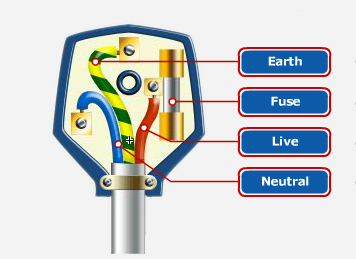Short Circuit Breaking Current of Circuit Breaker :
This is the maximum short circuit current which a circuit breaker can withstand before it. Finally cleared by opening its contacts. When a short circuit flows through a circuit breaker, there would be thermal and mechanical stresses in the current carrying parts of the breaker. If the contact area and cross-section of the conducting parts of the circuit breaker are not sufficiently large, there may be a chance of permanent damage in insulation as well as conducting parts of the CB.
As per Joule’s law of heating, the rising temperature is directly proportional to square of short circuit current, contact resistance and duration of short circuit current. The short circuit current continuous to flow through circuit breaker until the short circuit is cleared by opening operation of the circuit breaker. As the thermal stress in the circuit breaker is proportional to the period of short circuit, the breaking capacity of electrical circuit breaker, depends upon the operating time.
At 160°C aluminum becomes soft and losses its mechanical strength, this temperature may be taken as limit of temperature rise of breaker contacts during short circuit. Hence short circuit breaking capacity or short circuit breaking current of circuit breaker is defined as maximum current can flow through the breaker from time of occurring short circuit to the time of clearing the short circuit without any permanent damage in the CB. The value of short circuit breaking current is expressed in RMS. During short circuit, the CB is not only subjected to thermal stress, it also suffers seriously from mechanical stresses. So during determining short circuit capacity, the mechanical strength of the CB is also considered. So for choosing suitable circuit breaker it is obvious to determine the fault level at that point of the system where CB to be installed. Once the fault level of any part of electrical transmission is determined it is easy to choose the correct rated circuit breaker for this part of network.
As per Joule’s law of heating, the rising temperature is directly proportional to square of short circuit current, contact resistance and duration of short circuit current. The short circuit current continuous to flow through circuit breaker until the short circuit is cleared by opening operation of the circuit breaker. As the thermal stress in the circuit breaker is proportional to the period of short circuit, the breaking capacity of electrical circuit breaker, depends upon the operating time.
At 160°C aluminum becomes soft and losses its mechanical strength, this temperature may be taken as limit of temperature rise of breaker contacts during short circuit. Hence short circuit breaking capacity or short circuit breaking current of circuit breaker is defined as maximum current can flow through the breaker from time of occurring short circuit to the time of clearing the short circuit without any permanent damage in the CB. The value of short circuit breaking current is expressed in RMS. During short circuit, the CB is not only subjected to thermal stress, it also suffers seriously from mechanical stresses. So during determining short circuit capacity, the mechanical strength of the CB is also considered. So for choosing suitable circuit breaker it is obvious to determine the fault level at that point of the system where CB to be installed. Once the fault level of any part of electrical transmission is determined it is easy to choose the correct rated circuit breaker for this part of network.
Rated Short Circuit Making Capacity
The short circuit making capacity of circuit breaker is expressed in peak value not in rms value like breaking capacity.Theoretically at the instant of fault occurrence in a system, the fault current can rise to twice of its symmetrical fault level. At the instant of switching on a circuit breaker in faulty condition, of system, the short circuit portion of the system connected to the source. The first cycle of the current during a circuit is closed by circuit breaker, has maximum amplitude. This is about twice of the amplitude of symmetrical fault current waveform. The breaker’s contacts have to withstand this highest value of current during the first cycle of waveform when breaker is closed under fault. On the basis of this above mentioned phenomenon, a selected breaker should be rated with short circuit making capacity. As the rated short circuit making current of circuit breaker is expressed in maximum peak value, it is always more than rated short circuit breaking current of circuit breaker. Normally value of short circuit making current is 2.5 times more than short circuit breaking current.
Rated Operating Sequence or Duty Cycle of Circuit Breaker:
Rated Operating Sequence or Duty Cycle of Circuit Breaker:
This is mechanical duty requirement of circuit breaker operating mechanism. The sequence of rated operating duty of a circuit breaker has been specified as 

Where, O indicates opening operation of CB. CO represents closing operation immediately followed by an opening operation without any intentional time delay. t' is time between two operations which is necessary to restore the initial conditions and / or to prevent undue heating of conducting parts of circuit breaker. t = 0.3 sec for circuit breaker intended for first auto re closing duty, if not otherwise specified. Suppose rated duty circle of a circuit breaker is

This means, an opening operation of circuit breaker is followed by a closing operation after a time interval of 0.3 sec, then the circuit breaker again opens without any intentional time delay. After this opening operation the CB is again closed after 3 minutes and then instantly trips without any intentional time delay.
Rated Short Time Current
This is the current limit which a circuit breaker can carry safely for certain specific time without any damage in it. The circuit breakers do not clear the short circuit current as soon as any fault occurs in the system. There always some intentional and an intentional time delays present between the instant of occurrence of fault and instant of clearing the fault by CB. This delays are because of time of operation of protection relays, time of operation of circuit breaker and also there may be some intentional time delay imposed in relay for proper coordination of power system protection. Even a circuit breaker fails to trip, the fault will be cleared by next higher positioned circuit breaker. In this case the fault clearing time is longer. Hence, after fault, a circuit breaker has to carry the short circuit for certain time. The summation of all time delays should not be more than 3 seconds, hence a circuit breaker should be capable of carrying a maximum faulty current for at least this short period of time. The short circuit current may have two major affects inside a circuit breaker.
1. Because of the high electric current, there may be high thermal stress in the insulation and conducting parts of CB.
2. The high short circuit current, produces significant mechanical stresses in different current carrying parts of the circuit breaker. A circuit breaker is designed to withstand these stresses. But no circuit breaker has to carry a short circuit current not more than current for a specified short period. The rated short time current of a circuit breaker is at least equal to rated short circuit breaking current of the circuit breaker.
Rated Voltage of Circuit Breaker Rated voltage of circuit breaker depends upon its insulation system. For below 400 KV system, the circuit breaker is designed to withstand 10% above the normal system voltage. For above or equal 400 KV system the insulation of circuit breaker should be capable of withstanding 5% above the normal system voltage. That means, rated voltage of circuit breaker corresponds to the highest system voltage. This is because during no load or small load condition the voltage level of power system is allowed rise up to highest voltage rating of the system.
Source : Electrical4u
2. The high short circuit current, produces significant mechanical stresses in different current carrying parts of the circuit breaker. A circuit breaker is designed to withstand these stresses. But no circuit breaker has to carry a short circuit current not more than current for a specified short period. The rated short time current of a circuit breaker is at least equal to rated short circuit breaking current of the circuit breaker.
Rated Voltage of Circuit Breaker Rated voltage of circuit breaker depends upon its insulation system. For below 400 KV system, the circuit breaker is designed to withstand 10% above the normal system voltage. For above or equal 400 KV system the insulation of circuit breaker should be capable of withstanding 5% above the normal system voltage. That means, rated voltage of circuit breaker corresponds to the highest system voltage. This is because during no load or small load condition the voltage level of power system is allowed rise up to highest voltage rating of the system.
| Nominal System Voltage | Highest System Voltage | Power Frequency Withstand Voltage | Impulse Voltage Level |
| 11 KV | 12 KV | - | - |
| 33 KV | 36 KV | 70 KV | 170 KV |
| 132 KV | 145 KV | 275 KV | 650 KV |
| 220 KV | 245 KV | 460 KV | 1050 KV |
| 400 KV | 420 KV | - | - |











